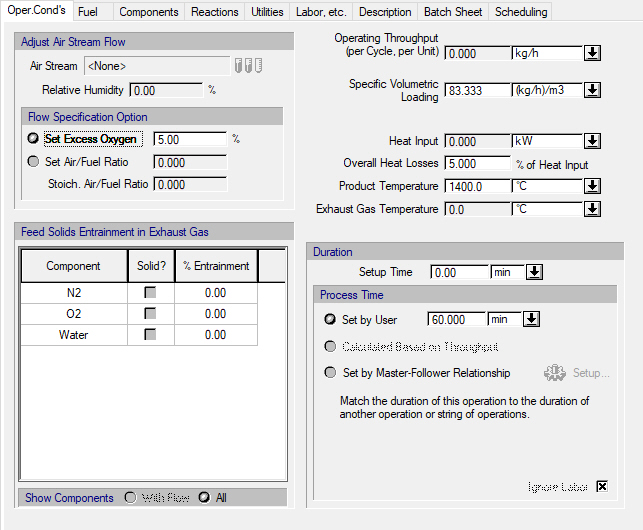

The following table shows a brief description of the variables appearing in this tab. The table also displays their default values and their generally acceptable range:
|
Variable |
Default Value |
Range |
|
|
||
|
● Air Stream |
<None> |
Dedicated Input Port |
|
● Relative Humidity (%) |
0.0 |
0-100 |
|
◙ Excess Oxygen (%) |
5.0 |
0-100 |
|
◙ Air-Fuel Ratio |
0.0 |
Positive |
|
● Stoichiometric Air-Fuel Ratio |
0.0 |
Positive |
|
● Is Solid? |
No |
Yes/No |
|
○ % Entrainment |
0.0 |
0-100 |
|
● Operating Throughput (per Cycle, per Unit) (kg/h) |
0.0 |
Positive |
|
● Specific Volumetric Loading (kg/h-m3) |
0.0 |
Positive |
|
● Heat Input(kW) |
0.0 |
Positive |
|
○ Overall Heat Losses (%) |
5.0 |
0-100 |
|
○ Product Temperature (oC) |
1400.0 |
0-100 |
|
● Exhaust Gas Temperature (oC) |
0.0 |
0-100 |
Symbol Key: ○ User-specified value (always input); ● Calculated value (always output); ◙ Sometimes input, sometimes output
The following list describes the available specification choices in this tab; for more details on how these are implemented, see Continuous Stoichiometric Reaction in a Rotary Kiln: Modeling Calculations.
•Air flow specification options...
You may choose to either specify the percent excess oxygen of the air stream or the air-fuel ratio.
•Duration options...
Duration options are only available in batch mode. You can set the process time, or have the process time calculated based on operating throughput, or match the duration of this operation to the duration of another operation by introducing a master-slave relationship between the two operations. If you introduce a master-slave relationship, the program will match the setup time, the process time and the turnaround time of this operation (the ‘slave’) with the corresponding times of the reference operation (the ‘master’ operation). For more details on how to setup a master-slave relationship, see The Scheduling Tab.